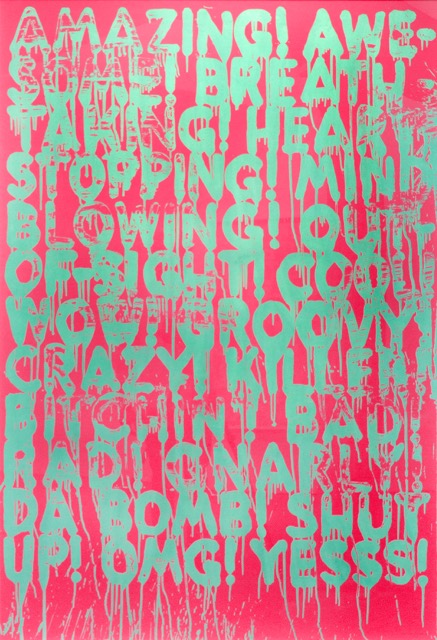Mel Bochner – Amazing (Inverse)
Mel Bochner, Amazing (Inverse) is an original Silkscreen with color shifting inks on Lanaquarelle Satin paper. This print is signed and numbered from the edition of 20. Published by Two Palms, New York.
Mel Bochner is an American Conceptual artist best known for his text-based paintings. Bochner’s popular thesaurus painting series consists of lists of synonyms displayed in rainbow-colored palettes, often featuring a single word repeated in painterly capital letters, as seen in his seminal piece Blah, Blah, Blah (2008). “My feeling was that there were ways of extending, or re-inventing visual experience, but that it was very important that it remain visual,” he reflected on introducing text into his work. “The viewer should enter the idea through a visual or phenomenological experience rather than simply reading it.”
Mel Bochner is recognized as one of the leading figures in the development of Conceptual art in New York in the 1960s and 1970s. Emerging at a time when painting was increasingly discussed as outmoded, Bochner became part of a new generation of artists which also included Eva Hesse, Donald Judd, and Robert Smithson – artists who, like Bochner, were looking at ways of breaking with Abstract Expressionism and traditional compositional devices.
| Title | Amazing (Inverse) |
|---|---|
| Medium | Silkscreen |
| Year | 2014 |
| Edition | 20 |
| Signature | Signed, dated, numbered |
| Size | 68.5 x 47 (in) 174 x 119 (cm) |
| Price | SOLD |
Description
Mel Bochner, Amazing (Inverse) is an original Silkscreen with color shifting inks on Lanaquarelle Satin paper. This print is signed and numbered from the edition of 20. Published by Two Palms, New York.
Mel Bochner is an American Conceptual artist best known for his text-based paintings. Bochner’s popular thesaurus painting series consists of lists of synonyms displayed in rainbow-colored palette, including Amazing (inverse), often featuring a single word repeated in painterly capital letters, as seen in his seminal piece Blah, Blah, Blah (2008). “My feeling was that there were ways of extending, or re-inventing visual experience, but that it was very important that it remain visual,” he reflected on introducing text into his work. “The viewer should enter the idea through a visual or phenomenological experience rather than simply reading it.”
Mel Bochner is recognized as one of the leading figures in the development of Conceptual art in New York in the 1960s and 1970s. Emerging at a time when painting was increasingly discussed as outmoded, Bochner became part of a new generation of artists which also included Eva Hesse, Donald Judd, and Robert Smithson – artists who, like Bochner, were looking at ways of breaking with Abstract Expressionism and traditional compositional devices.
Bochner came of age during the second half of the 1960s, a moment of radical change both in society at large as well as in art. While painting slowly lost its preeminent position in modern art, language moved from talking about art to becoming part of art itself. Bochner has consistently probed the conventions of both painting and of language, the way we construct and understand them, and the way they relate to one another to make us more attentive to the unspoken codes that underpin our engagement with the world.
Additional information
| Title | Amazing (Inverse) |
|---|---|
| Medium | Silkscreen |
| Year | 2014 |
| Edition | 20 |
| Signature | Signed, dated, numbered |
| Size | 68.5 x 47 (in) 174 x 119 (cm) |
| Price | SOLD |


